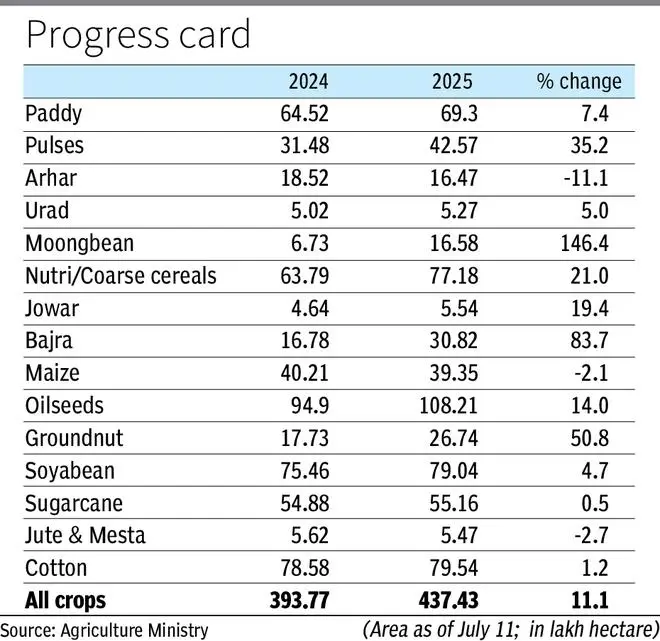On July 4, the season’s acreage was more than 11 per cent higher than the previous year
| Photo Credit:
BADIGER PK
Low rainfall in parts of India’s southern, eastern, and north-eastern regions, combined with very heavy rainfall in some key agricultural areas of central and north-western India, slowed the pace of kharif sowing in the week ending July 11. Approximately 160 lakh hectares (lh) were covered, a decrease from the 180 lh recorded in the previous week ending July 4.
Despite this weekly slowdown, overall kharif sowing remains robust. Latest data show that the total coverage reached 597.86 lh as of July 11, a 7 per cent increase compared with 560.59 lh during the same period last year. On July 4, the season’s acreage was more than 11 per cent higher than the previous year.

Upbeat sentiment
“Rainfall plays a major role in deciding sowing, whether it’s too little or too heavy,” explained a senior official. “While there may be temporary differences in weekly coverage compared to year-ago data, farmers’ sentiments are generally good, and they are optimistic about another year of bumper harvest.” However, the official cautioned that the quantitative rainfall in September would need close monitoring, as any flooding during that period could be harmful to crops like pulses and oilseeds.
According to India Meteorological Department (IMD) data, monsoon rainfall in the first 14 days of July (July 1-14) was 10.3 per cent higher than normal at 131.6 mm. This is against the usual 119.3 mm for the period. This brings the season’s total rainfall across the country to 311.6 mm since June 1, which is 9.5 per cent above normal.
Regionally, during July 1-14, East and North-East India experienced a 36 per cent rainfall deficit, while the South Peninsula received 22 per cent below normal rainfall. Conversely, the central meteorological subdivision, which includes Odisha, Chhattisgarh, Madhya Pradesh, Maharashtra, and Gujarat, reported a 49 per cent surplus. The North-West region, comprising Punjab, Haryana, Rajasthan, and Uttar Pradesh, received 20 per cent above normal rainfall.
Officials noted that Madhya Pradesh had a 45 per cent rainfall surplus in June and 108 per cent above normal from July 1-14, while Gujarat saw a 115 per cent surplus in June and 34 per cent above normal from July 1-14, with most districts experiencing very heavy rainfall. Maharashtra, as a whole, had an 8 per cent surplus in July, although the cotton and soybean-growing Marathwada region remains largely deficient.
Crop-specific trends
The acreage for oilseeds, which had improved last week, lagged by 2 per cent at 137.27 lh from 139.82 lh. Specifically, the soyabean acreage dipped 8 per cent to 99.03 lh from 107.78 lh a year ago. However, the groundnut acreage saw an 18 per cent increase to 32.99 lh from 28.04 lh, and sunflower area was slightly higher at 0.49 lh against 0.48 lh. The Ministry has not yet released state-wise sowing details. Cotton acreage o dropped by 2.5 per cent to 92.83 lh from 95.22 lh.
The acreage under paddy, the main kharif cereal, reached 123.68 lh, a 10.6 per cent increase from 111.85 lh a year ago. The pulse coverage jumped significantly by 25.7 per cent to 67.09 lh from 53.39 lh. Within the pulses category, urad (black matpe) acreage was 11.46 lh from 11.54 lh, and moong (green gram) surged to 23.16 lh from 12.19 lh. However, arhar (pigeon peas) sowing continued to lag at 25.42 lh against 27.18 lh last year, a 6.5 per cent decrease.
The coverage of nutri/coarse cereals increased by 16.6 per cent to 116.3 lh from 99.78 lh. The area under maize, which was down until July 4, is now up by 3.6 per cent at 61.88 lh from 59.73 lh. Jowar (sorghum) acreage reached 8 lh from 7.39 lh, and bajra (millet) increased to 44.01 lh from 29.59 lh.
There has been no update on sugarcane planting for the past two weeks, indicating that sowing is likely complete. The cane planted area remains at 55.16 lh against 54.88 lh last year. A revision in the current sugarcane area data may occur at the end of the season, as last year’s final estimate was 53.58 lh, lower than the year-ago number currently shown. Finally, jute and mesta coverage is down by 2.1 per cent at 5.53 lh from 5.65 lh, according to the data.
Published on July 14, 2025